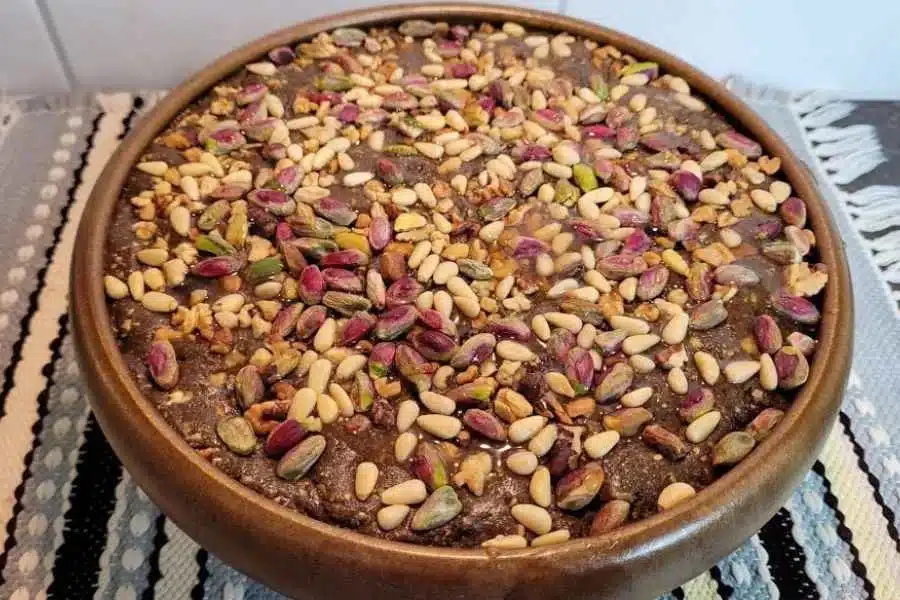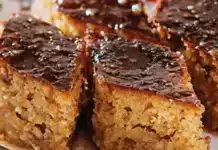Bsissa is a hearty porridge-like African dish made from a mixture of grains and legumes, which is loved in Tunisia, Algeria, and Libya, especially by the Berber people. This versatile porridge, with a chocolatey hue, is a go-to for breakfast, brunch, or a light lunch/dinner.
Bsissa’s taste varies across Tunisia—savory in the South with lentils and a hint of salt, sweeter in the North, a popular breakfast pick. Made from wheat or barley flour, chickpeas, and spices like coriander and fennel, it’s a mix of tradition and modern flair, sometimes even including chocolate or cocoa.
Bsissa isn’t just food; it’s a North African experience. With barley, chickpeas, and secret spices, it brings earthy goodness. It’s a warm hug for your taste buds, whisking you to lively North African markets and the stories behind each recipe.
The Roots of Bsissa
Bsissa is deeply rooted in Tunisian soil, representing not just a dish but an art of eating and a therapeutic culinary heritage. Its origins can be traced back to the Byzantine Empire, with certain mosaics in Tunisia incorporating it. Over the centuries, it has evolved to become a cherished part of Tunisian cuisine, served at various times throughout the day.
Nutritional Riches
Bsissa is a vegan, raw, and wholesome food made by blending cereals, roasted legumes, and tasty spices. Packed with vegetable proteins, fiber, slow sugars, and essential minerals like calcium, phosphorus, and iron, it’s great for kids’ growth.
The mix of flavorful spices adds a delicious touch, making Bsissa not just filling but also good for digestion. This traditional dish is so loved that Lamta, Tunisia, hosts an annual festival dedicated to celebrating its deliciousness.
Diverse Flavors and Adaptations
Bsissa, resembling a chocolate-colored paste, boasts a unique taste that varies across different regions of Tunisia. In the South, it takes on a savory note with lentils and a touch of salt, while in the North, it leans towards a sweeter profile, making it a popular breakfast choice.
The basic recipe involves a mixture of wheat or barley flour, chickpeas, and spices like coriander, fennel, and aniseed. Modern variations even include chocolate and cocoa, catering to evolving tastes.
You May Like
How to Make Bsissa

Ingredients:
- 1 cup barley
- 1/2 cup wheat berries
- 1/2 cup chickpeas
- 1/2 cup fava beans
- 1 teaspoon cumin powder
- 1 teaspoon caraway powder
- 1 teaspoon salt
- 6 cups water
Instructions:
- Start with washing the barley, wheat berries, chickpeas, and fava beans thoroughly. Make sure to remove all the dirt.
- Take a large size of pot in which all the ingredients can be mixed then mix them all together.
- Pour water into the pan and light the stove to bring a boil, then lower the heat when it starts boiling.
- Wait until the grains and legumes are tendered, during the process of simmer of around one hour.
- Use a blender to blend the cooked mixture for a smoother texture.
- Add your seasonings according to your taste.
- Sprinkle some cumin powder (optional) and your Bsissa is ready to be served warm.
Serving Suggestions:
Bsissa can be enjoyed in many ways:
- Add olive oil and honey to your Bsissa paste for a delicious and nutritious breakfast.
- Enjoy it with a smoothie or yogurt too for a protein boost.
- Wonder what, it can be served as a dip for vegetables and fruits.
- When you are short of spreads on your bread, use Bsissa paste instead.
- Give it a try with different spices like coriander, fennel, or aniseed.
- Enjoy it as a comforting porridge, garnished with a dash of cumin or caraway powder, or a sprinkle of fresh parsley.
- Elevate it by topping with a fried or poached egg, accompanied by a side of harissa or hot sauce for an extra kick.
- Enhance your salad taste by using it as a flavorful topping for a Mediterranean-style salad.
- Chill and serve it as a refreshing side dish at a summer barbecue.
- Pair it with your choice of protein, such as fish or chicken, as a delightful and complementary side.
Tips:
- Enhance the texture and flavor by combining a variety of grains and legumes.
- For quicker cooking and improved digestibility, soak the grains and legumes overnight before preparing.
- Use high-quality spices, such as cumin and caraway powder, to enhance the overall taste.
- Ensure even cooking by simmering the Bsissa over low heat, stirring occasionally; use a heavy-bottomed pot to prevent burning.
- Customize the seasoning according to your preferences—feel free to add more salt or spices to suit your taste.
- Intensify the flavor by mixing olive oil or crushed tomatoes into the mixture.
- Serve the Bsissa warm, garnish with a sprinkle of cumin or caraway powder, or some fresh parsley.
- For a gluten-free option, substitute wheat and barley with gluten-free grains like quinoa or millet.
- Get creative with additional protein and nutrition by experimenting with ingredients such as chickpeas, lentils, or other legumes.
- Refrigerate Bsissa in an airtight container, and use it for the next 5 days.
Ingredient Substitute:
- Barley: Use substitutes like farro, wheat, or quinoa for the same nutty flavor and chewy texture as barley.
- Wheat: It also adds nutty flavor and chewy texture, replace it with gluten-free options like millet or quinoa for those with gluten intolerance.
- Chickpeas: They give protein and a creamy texture, substitute it with lentils, fava beans, or green peas for a diverse twist.
- Fava beans: They add a creamy texture and nutty flavor, swap it with lentils, chickpeas, or green peas to experiment with different tastes and textures.
- Cumin powder: It infuses a warm, earthy flavor into Bsissa, try substitutes like caraway powder, coriander powder, or paprika for a unique twist.
- Caraway powder: It contributes a warm, earthy flavor, consider alternatives like cumin powder, coriander powder, or fennel seeds for a distinctive taste.
- Salt: It enhances the taste of Bsissa, experiment with alternatives like bouillon powder or vegetable broth.
- Water: It serves as the cooking liquid, and enhances Bsissa’s taste by using vegetable or chicken broth as a flavorful substitute for it.
Conclusion:
Bsissa is a delicious and nutritious dish that is easy to make and can be enjoyed in a variety of ways. If you are looking for a new and exciting dish to try, I highly recommend it.
I hope you enjoyed this article about Bsissa. If you have any questions, please feel free to leave a comment below.
FAQS:
Is Bsissa a high-calorie food?
No, Bsissa is not considered fattening, as it contains 283 calories. It can be consumed in both liquid and solid forms. The slow sugars and fibers in it make it beneficial for diabetics, helping to regulate blood sugar levels.
Is Bsissa suitable for children?
Yes, Bsissa is a nutritious option for children. Packed with iron, calcium, and phosphorus, it supports their development and growth.
Is Bsissa suitable for specific diets?
Absolutely! Bsissa is a great choice for athletes and those on a diet, thanks to its wholesome ingredients and balanced nutritional profile.
Why should I include Bsissa in my diet?
Bsissa is commonly eaten for breakfast and gains significance during fasting periods due to its nutritional qualities and calorie richness, helping individuals better manage hunger throughout the day. Additionally, it holds cultural significance, being enjoyed during childbirth celebrations in Tunisian tradition.
What are the best accompaniments for Bsissa?
Bsissa pairs well with dates and dried fruits, enhancing its flavors and providing a delightful eating experience.








